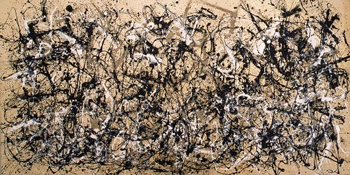
Autumn Rhythm (number 30)

|
Autumn Rhythm (number 30)
Autumn Rhythm is an important work as it is an early and magnificent example of abstract expressionism, which emphasized grand movements and valued the act of creation. Pollock abandoned all notions of painterly tradition with this work. His seemingly irrational and totally abstract style would influence generations of artists.
In the mid 1940s, Pollock became disinterested in traditional methods of painting. At this point, he began to drip and pour different types of paint over unprimed canvases tacked to his studio floor. The artist would walk all over the canvas, holding a paint can in one hand and a brush in the other. This dripping technique was used to create Autumn Rhythm. Although the painting appears completely abstract, the artist drew human forms in each of the three main sections of the work. These forms were eventually buried under the unordered lines and paint blobs, but their presence indicates Pollock's continued impulse towards the figurative despite the apparent spontaneity of the work.
The final work appears as an altogether abstract composition with no obvious focal point. The painting is a network of lines and splats. Pollock began by spreading a thin black line across the canvas and then added to the composition with broad strokes of beige and white. The superimposition of lines moving in various, unordered directions causes restlessness and chaos. The edges of the canvas are left bare and untouched, they create a type of frame for the work and provide some balance and stability.
Autumn Rhythm conjures up a sense of cosmic forces which are constantly moving without beginning or end. Pollock created this feeling by relinquishing all conscious control of his work. This notion of abandoning personal power to the artistic process is Pollock's great contribution to modern art.












